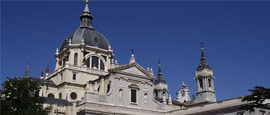More than 10km (6 miles) long, the Madrid Río has transformed a previously neglected part of the city to create an urban park on the banks of the Manzanares River. Dotted with historic monuments, viewpoints, pedestrian and cycle paths, it symbolises a hugely successful riverfront regeneration scheme; previously an ugly motorway scythed through this part of the city. Highlights include an orchard restored with more than 800 fruit trees, a glasshouse, a city beach and children's playgrounds.
Things to see in Madrid
Tourist offices
Address: Plaza Mayor 27, Madrid, Spain
Tel: +34 91 578 78 10.
Opening Hours:
Daily 0930-2030.
www.esmadrid.comThe main tourist office in Plaza Mayor (Madrid's main square) offers maps, directions and the usual advice on where to go and what to do. Staff usually speak English. There are also branches in: Aeropuerto de Barajas Terminal 2 and Terminal 4 (tel: +34 91 578 78 10; open daily 0900-2000); Plaza de Neptuno (open daily 0930-2030); Plaza de Callao (open daily 0930-2030); Paseo Recoletos 23 (open daily 1100-2000); and Ronda de Atocha (open daily 1100-2000).
The Madrid Card (www.madridcard.com), valid for one, two or three days, gives visitors free admission to over 40 major museums, the Madrid Vision bus tour, as well as discounts in selected shops, restaurants, theatres and more. The cards can be purchased from main tourist offices or online.
The Prado Museum (founded in 1819) is among Europe's greatest art galleries. Within its 4,000-strong collection of 16th to early 19th-century paintings are masterpieces by Fra Angelico, Botticelli, Bosch (El Bosco), Titian, Rembrandt and Velázquez, as well as evidence of the astonishing development of Goya – from his sun-soaked early paintings of dances and festivities to the grim madness of his black period.
Designed by the Spanish architect Antonio Fernánez Alba in 1977, Reina Sofia was completed in 1990. Officially opened by the King and Queen in 1992, it is dedicated to Spanish 20th-century art, pride of place belonging to Picasso's Civil War-era masterpiece, Guernica. Dalí, Miró and Juan Gris are among the other artists on show. More recently the museum has expanded with a building created by the French architect Jean Nouvel. The expansion houses the museum's library, a 450-seat auditorium and temporary exhibition galleries.
With the opulence of Versailles in mind, Philip V commissioned Italian architects Giambattista Sacchetti and Francesco Sabatini to build the Royal Palace, following a fire that destroyed the medieval Alcázar in the 18th century. Although the Royal Palace is his official residence, the king does not reside there; this means the 3000-room extravaganza is only used for state functions. The rest of the time, the startling white building in granite and Colmenar stone is open for tours and individual visits. Highlights include the Hall of Halberdiers and Hall of Columns, the Throne Room with its 17th-century sculptures, and the lavish private apartments.
This lush park in the heart of Madrid was originally the private garden of Philip IV. Visitors can enjoy a stroll along the shady avenues and formal gardens, take a rowing boat out on the lake or picnic in the extensive wooded areas. Madrileños flock here on the weekends, when entertainment is provided by fortune tellers, pavement artists and circus acts. There is a children's puppet theatre and numerous refreshment points. Temporary art exhibitions are held in the Palacio de Cristal, Palacio de Velázquez and the Casa de Vacas.
This beautifully proportioned cobbled square was constructed under the reign of Philip III in the early 16th century - his statue stands proudly at the centre. Plaza Mayor was both a market place and the setting for public spectacles – everything from the ritual condemnation of heretics to bullfights and pageants. Today, tourists outnumber the locals but Plaza Mayor is still as lively as it was in the past, with shops and cafés in the covered arcades.
Founded by Juana de Austria, the daughter of Charles V, in 1559, as a retreat for noblewomen, the Convento de las Descalzas Reales is still a functioning convent. A superb example of 16th- to 17th-century baroque architecture, it contains a magpie's hoard of artistic treasures, including Flemish tapestries, Italian and Flemish paintings and sculptures, religious artefacts and more. The convent is open for guided tours only. Tours are in Spanish, although questions are taken in English.
Madrid purchased the private collection of Hans-Heinrich Thyssen-Bornemisza after a nine-and-a-half-year loan, instantly enriching the city's fund of art treasures. The collection contains over 1,600 paintings, sculptures, carvings and tapestries, ranging from primitive Flemish works to contemporary pieces. Highlights include works by Fra Angelico, Van Eyck, Dürer, Caravaggio and Rubens.
The non-profit foundation Mapfre has two exhibition halls a stone's throw from one another on one of Madrid's grandest thoroughfares. With low-priced tickets and expansive exhibitions of superb quality, it's one of the city's most overlooked artistic treasures. Expect work from renowned photo artists, collaborations with galleries such as Musée d'Orsay in Paris, and extraordinary painting, sculpture and other exhibitions – Mapfre prides itself in celebrating all artistic disciplines.
This modern and vast green space (Madrid's biggest park) holds within it the recinto ferial (fairground), where most of Madrid's exhibitions take place. It also holds a large collection of macro-sculptures in Spain. People come here to walk, ride their bicycles, fly kites and fish. There is even an enclosure to exercise dogs.
Do you have any Feedback about this page?
© 2025 Columbus Travel Media Ltd. All rights reserved. No part of this site may be reproduced without our written permission, click here for information on Columbus Content Solutions.








 You know where
You know where